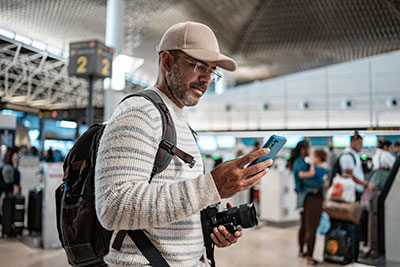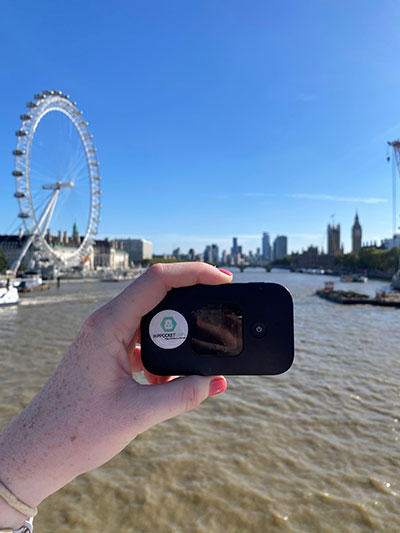Last updated February 7, 2024
Click below to listen to our Consumerpedia podcast episode.
Passport? Check. Flights, accommodations, and tours booked? Check. Bags packed? Checkity-check. Made sure your phone will still work when abroad? Well, it probably will, but without doing some advance planning you might get hit with a huge bill.
When you travel outside the U.S. you leave behind the cellular networks maintained by AT&T, T-Mobile, and Verizon. Because the major American mobile companies have agreements with foreign networks, your phone will automatically switch to them when you arrive. But with most U.S. mobile companies you’ll pay extra to “roam” on non-U.S. networks, and some companies—especially Verizon and Xfinity Mobile—charge big fees for talking, texting, and data while abroad. Customers of some resellers can’t connect to foreign cellular networks at all.
International travelers have several options for staying connected, including ditching your U.S. carrier in favor of local ones. Unfortunately, most options incur extra costs, and the least expensive methods are a bit of a hassle to set up. Here’s a rundown of what’s available.

Option 1: Stick with Your U.S. Mobile Company
This is the easiest route, but potentially pricy.
The advantage is that you’ll be able to use your phone just like you do at home after your plane lands, but this convenience often comes with an expensive catch in the form of international roaming fees, and while some cellular companies have reasonable rates, others charge for every little thing. And some resellers, including Cricket, Straight Talk, Tracfone, and Visible, don’t offer international roaming outside of Canada and Mexico.
The first step is to turn on international roaming capabilities for your phone. Do this in the “Cellular” or “Mobile Network” menu under “Settings.” Also contact your cellular provider to make sure international connections are authorized for your account. Note: If your phone is more than 10 years old, or if you’re on a prepaid calling plan, you might have to make different arrangements.
Below are summaries of costs for international cell service for AT&T, T-Mobile, and Verizon, plus some popular resellers. Because some companies’ offerings vary by location—for example, Xfinity’s Global Travel Pass works in Norway, but in Sweden you’ll get charged its pay-as-you-go rates—do your own checks for your destination(s).
- AT&T—Customers enrolled in its “unlimited” plans get free calling, texting, and data within Canada and Mexico; elsewhere, they automatically get charged for AT&T’s International Day Pass when roaming abroad, which costs $10/day ($5/day for each additional phone on account). AT&T charges its Day Pass fee for only up to 10 days per billing cycle. AT&T customers not enrolled in “unlimited” plans can sign up for the Day Pass; if they don’t, they are charged pay-as-you-go rates of $1–$3/minute to talk, $.50–$1.30 to text, and $2.05–$10.24/MB for data.
- T-Mobile—For travel in Canada and Mexico, all customers get free calling and texting, plus generous data allowances. In other foreign countries, fees depend on which monthly plan you have. Customers with T-Mobile’s Go5G, MAX, and Plus plans get up to 5GB of high-speed data at no extra charge. Those with Go5G Plus, Go5G, MAX, Plus, Magenta, ONE, and Simple Choice plans get unlimited texting and data at no extra charge, but unless they sign up for a separate calling plan for $5/day, they’ll pay $.25/minute for phone calls.
- Verizon—By default, customers roaming abroad are charged pay-as-you-go fees, which are astonishingly expensive: Depending on the country, Verizon charges $.99–$2.99/minute for calls; up to $.50 per text message; and $2.05/MB for data. For most, a better choice is to sign up for Verizon’s optional TravelPass, which costs $10/day per line ($5/day in Canada and Mexico) and provides free calling, texting, and data allowances. If your trip is longer than 10 days, sign up for Verizon’s optional International Monthly Plan, which costs $100/month per line.
- Google Fi—All customers get free calling and texting in Canada and Mexico. Fi’s Unlimited Plus customers get free texting and data abroad, but pay $.20/minute for calls. Fi’s Flexible plan members get free texting and pay $10/GB for data, and $.20/minute for calls. Customers enrolled in Fi’s Simply Unlimited plan can’t make cellular calls, text, or use data while outside the U.S., Canada, or Mexico.
- Xfinity—Costs are similar to those for Verizon, for which Xfinity is a major reseller. By default, customers roaming abroad are charged expensive pay-as-you-go rates: Depending on the country, it costs $.10–$2/minute for calls; $.05–$1 per text; and $.10–$2/MB for data. For most, a better choice is to sign up for Xfinity’s Global Travel Pass, which costs $10/day per line ($5/day in Canada and Mexico) and provides free calling, texting, and data allowances. Unlike Verizon, Xfinity doesn’t offer a monthly plan for long trips—go on a three-week trip and you’ll pay $210 to use your phone.
- Boost Mobile—Customers must have phones equipped with eSIM technology (see next section) and purchase credits to offset international roaming fees and usage charges that vary by country. For Europe, a $20 eSIM provides 5GB of data over 15 days.
- Consumer Cellular—Pay-as-you-go fees for each call, text, and MB of data, with rates varying by region. Advertised rates for France, for example, are $.06–$.29/minute for calling, $.06 per text, and $.06–$.23/MB for data.
- Mint Mobile—Customers can purchase credits to offset its pay-as-you-go fees for each call, text, and MB of data, with rates varying by region. Advertised rates for most of Western Europe, China, Japan, and Australia are $.25/minute for calling, $.02 per text, and $.02/MB for data.
- Cricket, Straight Talk, Tracfone, and Visible—No international cellular roaming arrangements outside Canada and Mexico.
Among the largest U.S. cellular services, T-Mobile and Google Fi stand out as the best options for international travelers. Outside North America, most of T-Mobile’s customers get free data—although you’ll want to avoid long phone conversations to duck its $.25/minute charge. And most Google Fi customers can continue to use their phones as they do at home and pay no extra international roaming fees; Fi’s top-tier Unlimited Plus plan costs only $65/month ($110/month for two phone lines).
But unless you plan to rely on public Wi-Fi (see below) or use very little data, pay-as-you-go options for AT&T, Verizon, and Xfinity are astonishingly expensive. Definitely sign up for day passes—although you’ll still get hit with a big bill: For a one-week trip, a family of two would pay $105 in fees with AT&T and $140 with Verizon or Xfinity.
Unfortunately, while many resellers offer great savings for domestic use compared to AT&T, T-Mobile, and Verizon, charging rates as low as $25/month for domestic calling and data, these lesser-known companies are mostly inadequate for most international travelers who need more than just Wi-Fi access. Mint does charge reasonable pay-as-you-go prices, but having to purchase credits periodically to buy more data allowances can make it a pain to use.
Many of the companies we shopped provide confusing and vague explanations of how they calculate international roaming charges. The lack of details offered by Consumer Cellular, which markets to older adults, is particularly worrisome: Its website states that while in France, it charges $.06 to $.29 per minute for calls and provides the same range per MB of data. What will we be charged while in Paris? In Marseille? While touring Versailles? The company’s website provides no answers.
Finally, check on data caps; especially when abroad, “unlimited” data usually doesn’t mean what it says. If you go over a company’s cap, you’ll usually see reduced speeds.

Option 2: Use Your Phone, but Swap in a Foreign SIM or Activate an eSIM
One way to avoid the expensive international roaming fees charged by some U.S. cellular companies is to switch your business to a foreign provider when you arrive. You can do this by buying and installing onto your phone a different SIM [Subscriber Identity Module], which is the device that authorizes access to cellular networks.
For most phones, swapping out SIM cards involves using a small tool that pops open a drawer that houses a tiny chip; take out the one that lets your phone connect to your domestic cellular carrier and put in one you can purchase to use on an international mobile network. Many new cell phones do away with physical SIM cards, instead using electronic SIM, or “eSIM,” which allows their owners to more easily switch their phones to different networks. Simply purchase an eSIM before your trip and scan the QR code on your phone to set it up.
First, contact your U.S. carrier to check that your phone is “unlocked;” if it’s not, request it do so. You can’t use a different SIM card or install an eSIM if your phone is locked to your carrier’s network.
Next, consider whether to buy a local SIM or a multi-national one. If you’re planning to spend all your time in one country, you’ll save some money by purchasing a SIM from a local carrier when you arrive at your destination. You can buy them at airport kiosks, but the best prices are available at carriers’ stores or authorized retailers. Note that unless you have a dual-SIM phone, installing a foreign SIM means you’ll get a new, local phone number, and temporarily lose your original one. So make sure to share your new digits with friends, family, and travel contacts.
Popular foreign SIM and eSIM providers include Orange Travel, Airalo, aloSIM, and SimOptions. Costs with each vary depending on where you’re traveling, but are far less than the $10/day fees you’d pay with AT&T or Verizon. For example, for Argentina, all these SIM sellers offer eSIM packages that include 5MB of data for less than $35 that are good for 30 days. Need more data? Just go to the company’s website and add it. The blog Too Many Adapters provides great how-to advice and pricing info for SIM options in most foreign countries.
Another option is to buy a multi-national/international SIM. This is a better choice if you’ll be visiting multiple countries, or you want to avoid the hassle of purchasing a SIM card after you arrive at your destination. Orange Travel offers a prepaid 14-day, 10GB data-only global SIM for about $55. If you’re traveling in Europe, it offers a 14-day prepaid SIM with unlimited talk and text within Europe, 200 texts and 30 minutes of calls to other countries, and 8GB of data for about $22. Both of these packages are available for phones that use SIM cards and eSIMs.
Note that available multi-national packages are mostly data-only; that means you won’t get a local phone number, and you’ll have to use Wi-Fi-friendly apps such as WhatsApp for calls and messaging with friends and family. If this is a deal-breaker, consider a physical, local SIM card instead.
 TIP: Outside the U.S., WhatsApp, a free messaging app owned by Facebook’s parent company, is ubiquitous for calling and texting. Install it on your phone to easily connect with drivers, vacation home managers, and tour guides.
TIP: Outside the U.S., WhatsApp, a free messaging app owned by Facebook’s parent company, is ubiquitous for calling and texting. Install it on your phone to easily connect with drivers, vacation home managers, and tour guides.
In some countries you’ll have to show your passport to authorize SIM purchases. Adding more data to your SIM card, or “topping up,” usually requires just logging on to the provider’s app or website and purchasing from there, but in some places, you may have to visit a store to buy additional credit.
Also note that in some countries, including Japan, it’s illegal to have a local phone number if you don’t have a residence there. That means you’re limited to data-only SIM cards.
Some other tips for using SIMs and eSIMs:
- If your phone uses a physical SIM card, make sure to bring along a SIM needle. It resembles the end of a paperclip and is used to pop open your phone’s card tray. We’ve heard from subscribers who broke their phones using wooden toothpicks and other apparatuses trying to pry this open.
- If you swap out physical SIM cards, make sure to stash your original one in a safe place after you remove it.
- Consider keeping in touch using WhatsApp or one of the other apps we list below under the Wi-Fi section of this article so your contacts back home don’t rack up a bill texting with a foreign phone number.
- If you’re going away for a month or longer, consider freezing your account with your U.S. carrier to avoid paying double for coverage. AT&T, T-Mobile, and Verizon allow this for up to 90 days.

Option 3: Rely on Wi-Fi Only
You can avoid paying all international roaming fees by keeping your phone in airplane mode and sticking with whatever free Wi-Fi you can find, or by renting a Wi-Fi pod.
Availability of free Wi-Fi varies tremendously depending on where you travel, and even in countries with extensive high-speed free wireless internet you’ll encounter fewer options the farther you travel from city centers.
Wi-Fi pods, on the other hand, connect to cellular networks, which you in turn access using your phone’s Wi-Fi signal. These devices are pocket-sized and available from car rental agencies and internet service providers.
For families who mostly stick together, a Wi-Fi pod is a potentially big money-saver; for example, instead of paying Verizon’s $10/day fee per person, they’d pay $8 to $15 total per day to connect to a shared Wi-Fi pod.
 TIP: Download offline maps. Whether you’re setting off for a U.S. or foreign destination, before you leave download an offline map of the area. This will allow you to navigate while traveling through areas with spotty cellphone coverage—and often when there’s no coverage at all—because your phone and navigation apps can still ping satellites to obtain GPS info. To download an offline map in Google Maps’ or Apple Maps’ mobile apps, look for it as an option after tapping on your pic or initials.
TIP: Download offline maps. Whether you’re setting off for a U.S. or foreign destination, before you leave download an offline map of the area. This will allow you to navigate while traveling through areas with spotty cellphone coverage—and often when there’s no coverage at all—because your phone and navigation apps can still ping satellites to obtain GPS info. To download an offline map in Google Maps’ or Apple Maps’ mobile apps, look for it as an option after tapping on your pic or initials.
It’s also important to search for destinations and “Wi-Fi rental” to compare prices online, find discount coupons, and choose the pick-up and drop-off methods most convenient for you. Here’s a sample of what Checkbook staff paid for unlimited portable Wi-Fi during recent trips:
- $6.50/day in Japan. Picked up at airport and mailed back in a local post box using the included prepaid envelope.
- $8.30/day in the U.K. Shipped to hotel and mailed back in a local post box using the included prepaid envelope.
- $9.50/day in Italy. Shipped to hotel and mailed back in a local post box using the included prepaid envelope.
- $13/day in Iceland. Reserved through a car-rental agency and picked up and dropped off at the same time as the car.
As with most other options, although Wi-Fi pod services often advertise “unlimited data,” most will throttle your speed if you go over 5GB per day several days in a row. And because devices typically have only six to eight hours of continuous battery life, consider getting a portable battery to keep it charged.
If you go the Wi-Fi-only route, you’ll likely need to set up a few new ways to stay in touch with important contacts:
- As we’ve already noted, in most foreign countries WhatsApp is used for calling and texting. It makes staying connected to your friends back home a breeze so long as they know that’s how to find you.
- If you use an iPhone, you can use Wi-Fi to send and receive iMessages (texts) and conduct voice calls via FaceTime. But texts you send to Android users—and those they send you—won’t go through unless you have a cellular connection.
- Social media and meeting apps such as Discord, Facebook Messenger, Google Hangouts, Signal, Skype, Teams, Viber, and Zoom all allow messaging and calls via Wi-Fi.


